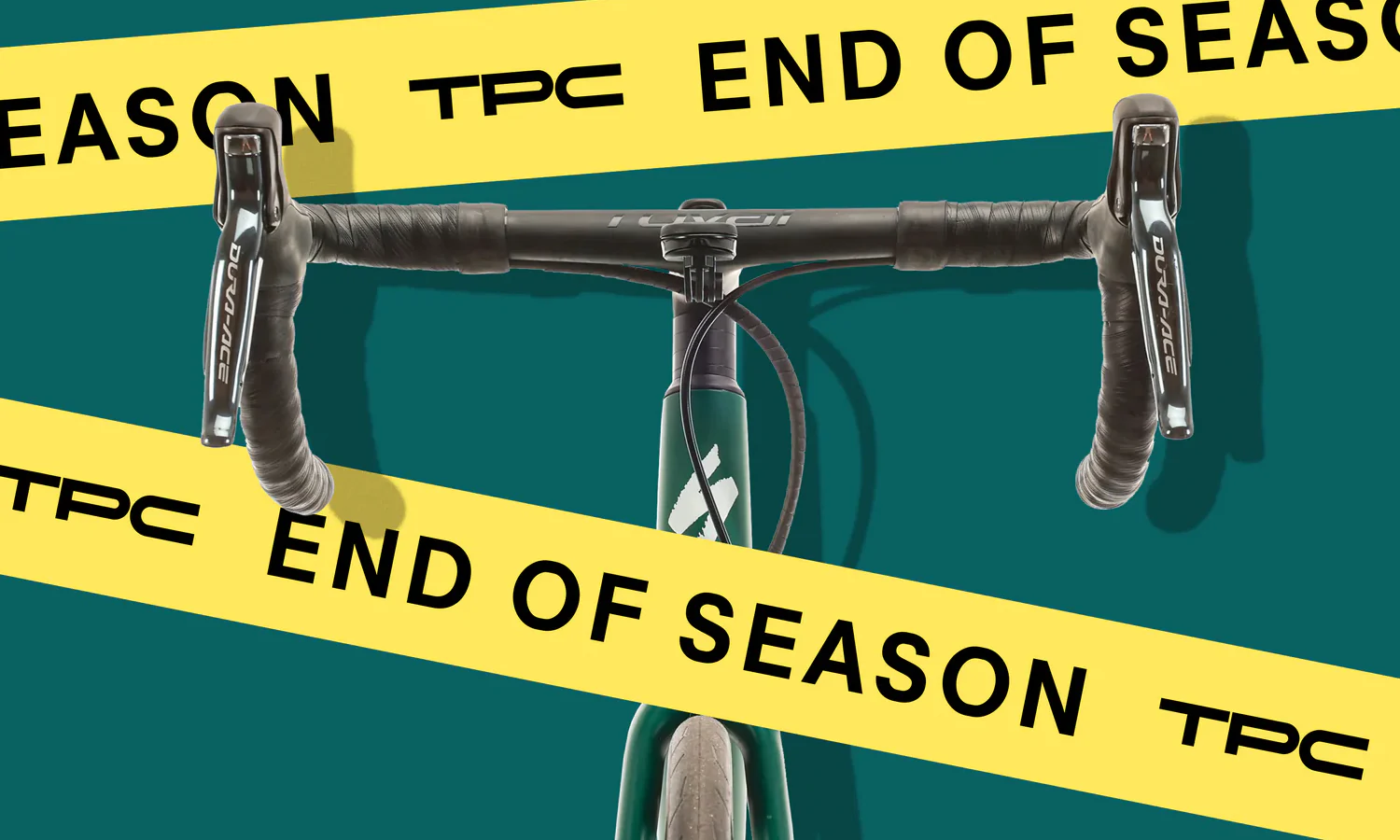Updated: October 3, 2020
Meet a group ride or watch a pro race and you're bound to see lots of riders aboard Specialized bikes. Specialized is one of the biggest bike producers in the world. Throughout the years, the California company has developed groundbreaking bikes, won countless races, and developed a large fanbase. It should come as no surprise that it is currently the most popular brand we sell at The Pro’s Closet.
Specialized produces everything from entry-level bikes to exorbitant dream bikes. Its catalog is expansive and covers all types of bikes from aero road to downhill mountain bikes. With so many Specialized models to choose from, how do you decide which bike is right for you? This overview covers all current Specialized models. Start by thinking about what type of riding you're planning to do on your new bike. Where will you go? Do you want to race? Hopefully, this guide helps you make an informed decision when buying your next bike. If you want to get a feel for these models in the flesh and get some expert advice while you’re at it, visit a Specialized retailer, including The Pro’s Closet’s Louisville/Denver bike store.
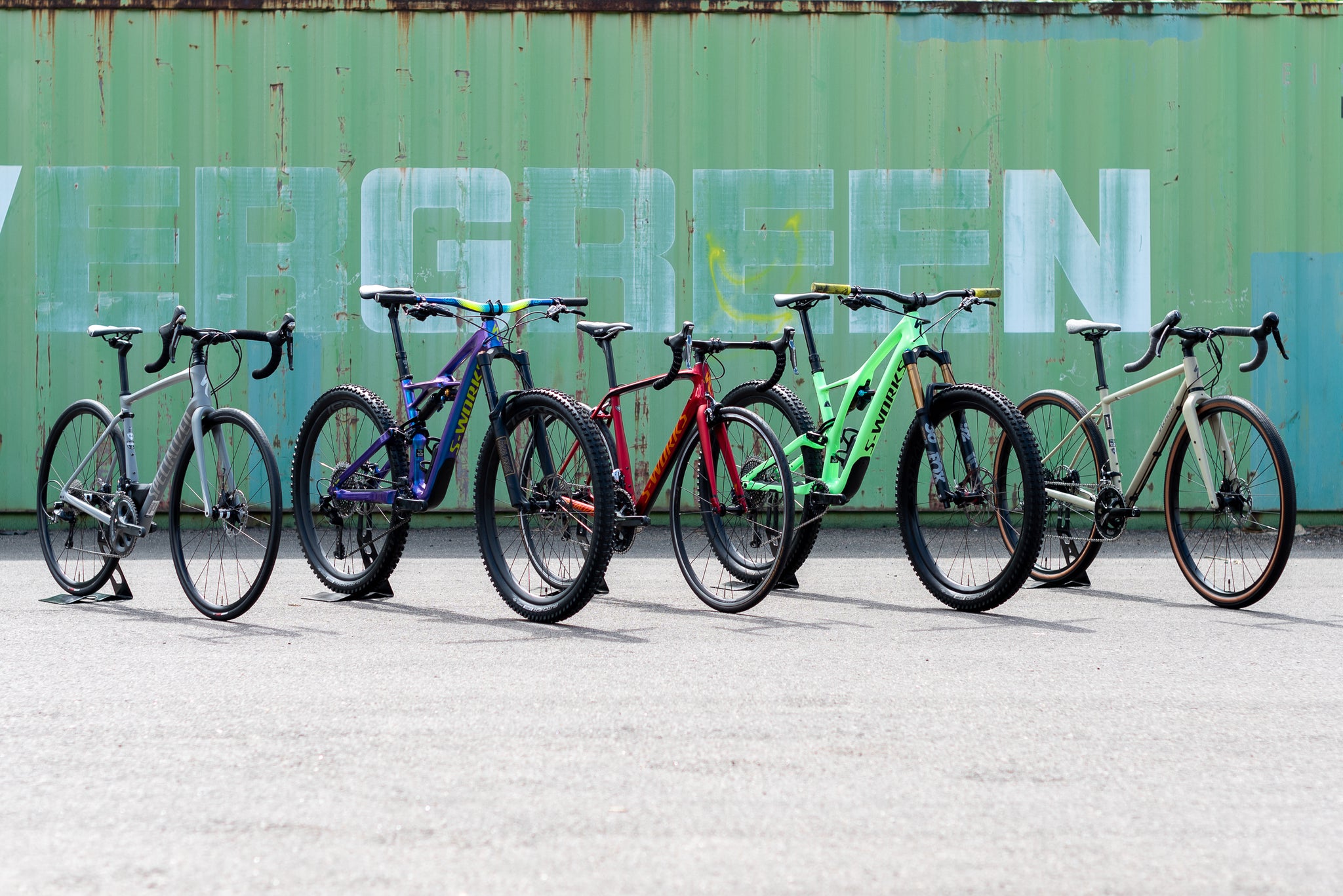 Some popular Specialized bikes. From left to right: Diverge, Enduro, Tarmac, Stumpjumper, Sequoia.
Some popular Specialized bikes. From left to right: Diverge, Enduro, Tarmac, Stumpjumper, Sequoia. Contents
- Specialized Build Levels
- Men's vs. Women's Models
- Carbon vs. Aluminum
- Rim vs. Disc Brakes
- Road Bikes
- Gravel / Cyclocross Bikes
- Time Trial / Triathlon Bikes
- Mountain Bikes
Specialized Build Levels
Throughout the Specialized bike line-up, there are often different component build levels for each model. The hierarchy of builds from lowest to highest is: Base, Sport, Elite, Comp, Expert, Pro, and then S-Works. For example, the various Specialized Tarmac builds will be named: Tarmac, Tarmac Sport, Tarmac Elite, Tarmac Comp, Tarmac Expert, Tarmac Pro, and the S-Works Tarmac.
These builds vary in the component spec level and, for carbon frames, the quality of carbon that is used in the construction. Sport is the entry-level build which uses less expensive, entry-level components, while S-Works is Specialized’s premium offering, and uses their lightest, high-modulus carbon and top-of-the-line componentry.
Men’s vs. Women’s Models
Specialized has historically offered women’s specific models like the Amira, Ruby, Dolce, Era, and Rhyme. However, data gathered from thousands of bike fits over the last decade have shown that many women’s bike fits don’t deviate far from men’s fits. As a result, Specialized decided to discontinue models with women’s specific geometry for models 2019 and later. Instead, each model will offer enough sizes to suit both genders and have different men's and women's component builds to address specific touch points.
For example, the Tarmac road racing bike now comes in sizes ranging from 44-61cm, and is available in a Tarmac Men’s and Tarmac Women’s build. The geometry is race-focused for both genders, but with gender-specific components like saddles and handlebars. Also, Specialized opts for different crank lengths to accommodate female riders.
Aluminum vs. Carbon
Many Specialized models are offered in both aluminum and carbon frames. Aluminum frames will often be used for more budget oriented builds, while carbon will be used for higher-end builds.
With some (but not all) Specialized bikes, aluminum models will be designated with an “E5" in the model name. For example, the Diverge Comp is carbon and the Diverge E5 Comp is aluminum. These builds have the same components but, because of the frame material, the E5 Comp will be less expensive.
Certain models only have one option for frame material.
If you’re interested in learning more about the differences between aluminum and carbon frames read our post on Frame Material.
Rim vs. Disc Brakes
Most Specialized road bikes have both rim brake and disc brake options available. Rim brakes are generally lighter, less complicated, and less expensive. Disc brakes provide more stopping power and work better in harsh conditions. Currently, disc brakes are becoming the preferred option, and rim brakes are more common on entry-level options.
All current Specialized gravel, cyclocross, and mountain bikes use disc brakes. Older model year cyclocross bikes will have cantilever rim brakes as Specialized didn't introduce a disc-compatible model until 2012.
Road Bikes
Road bikes are the lightest, fastest, and most efficient type of bike for riding on paved road surfaces. Specialized’s road bike options have different strengths and each bike serves a slightly different purpose. For more information on road bikes see our Road Bike Buyer’s Guide.
Road Racing Bikes
Road racing bikes will appeal most to competitive riders who want a bike that will maximize their efficiency and speed. Road racing bikes generally have a lower riding position, more aggressive geometry, greater stiffness, and more responsive handling.
Tarmac
Frame material: Carbon
Who it's for: Road racers, and dedicated enthusiasts who put in big miles and need a high-end tool for riding hard.
 The Specialized Tarmac is the classic road racing bike. It has an impressive history of racing success at the highest level of the sport, with victories in all three Grand Tours. The Tarmac is designed to do everything expected of a road racing bike exceptionally well: sprinting, cornering, climbing, and descending. The Tarmac is the sort of bike that appeals to serious riders looking to hammer, whether it's in races, groups ride, or when chasing Strava times. In Specialized’s road bike range, the Tarmac is also the lightest road frame available, making it a favorite for anyone who needs an edge on the climbs.
The Specialized Tarmac is the classic road racing bike. It has an impressive history of racing success at the highest level of the sport, with victories in all three Grand Tours. The Tarmac is designed to do everything expected of a road racing bike exceptionally well: sprinting, cornering, climbing, and descending. The Tarmac is the sort of bike that appeals to serious riders looking to hammer, whether it's in races, groups ride, or when chasing Strava times. In Specialized’s road bike range, the Tarmac is also the lightest road frame available, making it a favorite for anyone who needs an edge on the climbs.
2020 saw the release of the next generation Tarmac SL7. This new tarmac is now the flagship road bike in the Specialized range, replacing both the previous Tarmac SL6 and the Venge. The new Tarmac SL7 has become significantly more aerodynamic, allowing it to offer the best of both worlds, being both aero and light weight.
Related bikes: Amira
The Amira was the women’s specific version of the Tarmac. It has been discontinued since 2018.
Venge (discontinued)
Frame material: Carbon
Who it's for: Sprinters, breakaway artists, and riders looking to maximize their aerodynamic advantage for all-out speed on flat and rolling terrain.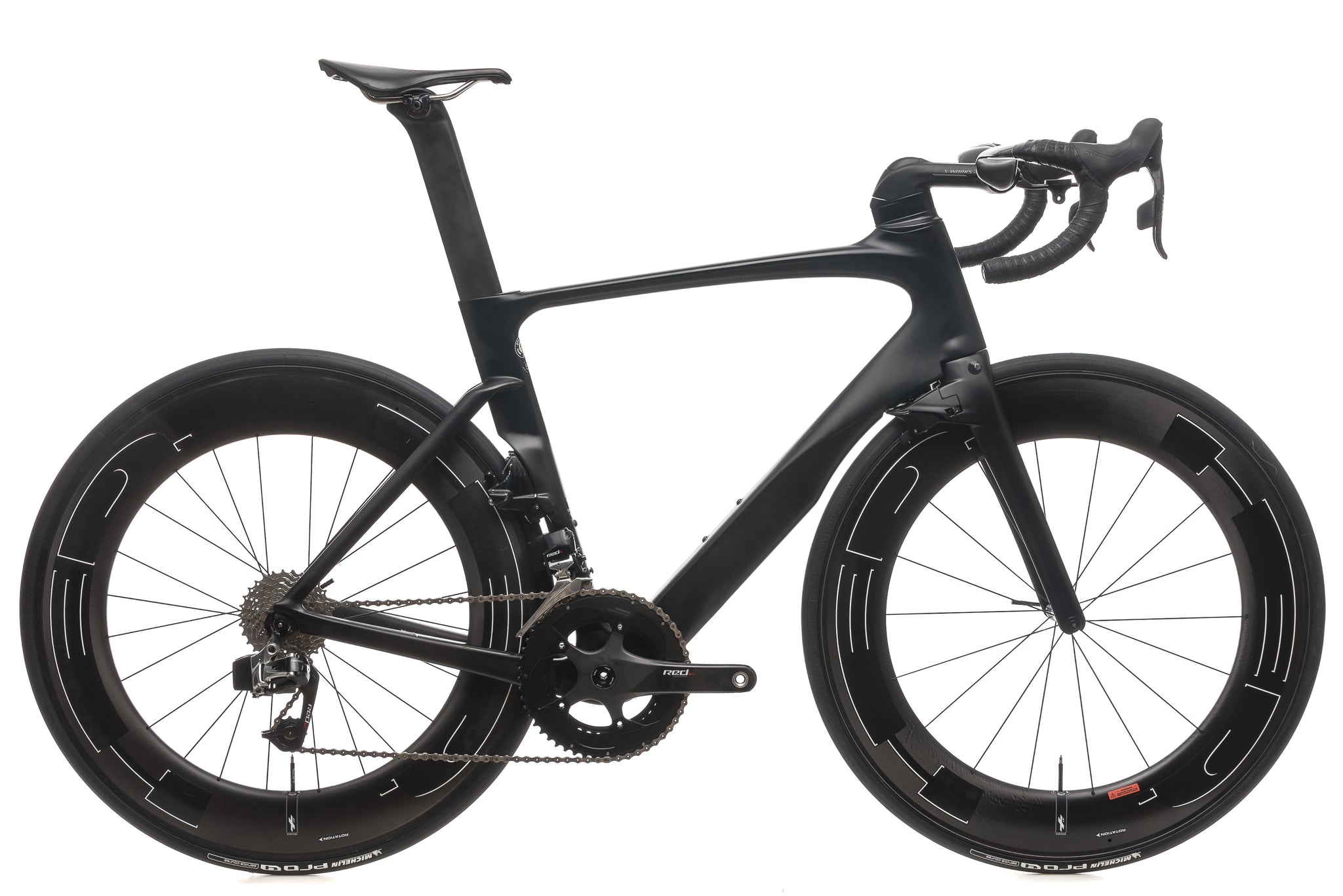
The Specialized Venge is an aero road bike that makes reducing aerodynamic drag its top priority. It was designed and refined in a wind tunnel and Specialized even collaborated with Formula 1 team McLaren to optimize the aerodynamics. Air resistance is one of the major elements riders have to work against, so the Venge helps to improve a rider's aerodynamic efficiency to increase average and top speed. The downside of the Venge’s aerodynamic shape is slightly heavier weight when compared to a classic road bike like the Tarmac. It may not climb as well as the Tarmac, but the aerodynamics will have a huge effect on speed when riding on flat and rolling terrain.
The Venge has been discontinued since 2020 with the introduction of the aerodynamic Tarmac SL7
Related bikes: Venge ViAS
The second generation Venge was named the Venge ViAS. This helped differentiate it from the first generation Venge which was still for sale. The Venge ViAS was designed to be even more aerodynamic than the original Vange. For 2019, the ViAS name has been discontinued and the newest version is simply called Venge.
Aethos
Frame material: Carbon
Who it's for: Climbers, weight weenies, and lovers of traditional bike design and ride quality.
The Aethos is Specialized's lightest road bike. In fact, at the time of writing it's the lightest production road disc frame ever made. With the Aethos, Specialized wanted to produce a bike less concerned with competition. It doesn't have the aero shaping found on many modern road bikes. Instead, it uses round-ish tube that joined into a traditional diamond-shaped frame. These tubes are pared down and tuned to create an ultra-light frame with excellent stiffness and handling. The Aethos will accelerate and climb quickly, and it provides a natural, sporty ride quality that cycling purists will surely appreciate. It share the same geometry as the Tarmac, so if you get along with the Specialized fit, there won't be any surprises. If you want to build the lightest road bike possible, conquer the steepest mountains, or just like how road bikes of the past looked, this is the Specialized to get.
Allez
Frame material: Aluminum
Who it's for: More budget-minded riders and racers who still want a competitive, fast, and well-rounded road bike.
The Specialized Allez is one of the most popular aluminum road bikes and can essentially be viewed as the aluminum version of the Tarmac, a road bike that is designed to excel in all road racing situations. The aluminum frame results in a lower overall cost, with the main trade-off being increased weight. With Specialized’s recent improvements in aluminum hydroforming technology, the current Allez has a ride quality that is almost as good as its carbon counterparts.
Allez Sprint
Frame material: Aluminum
Who it's for: Aggressive riders and racers who want the frame that’s budget friendly but aerodynamic, and incredibly stiff and responsive. 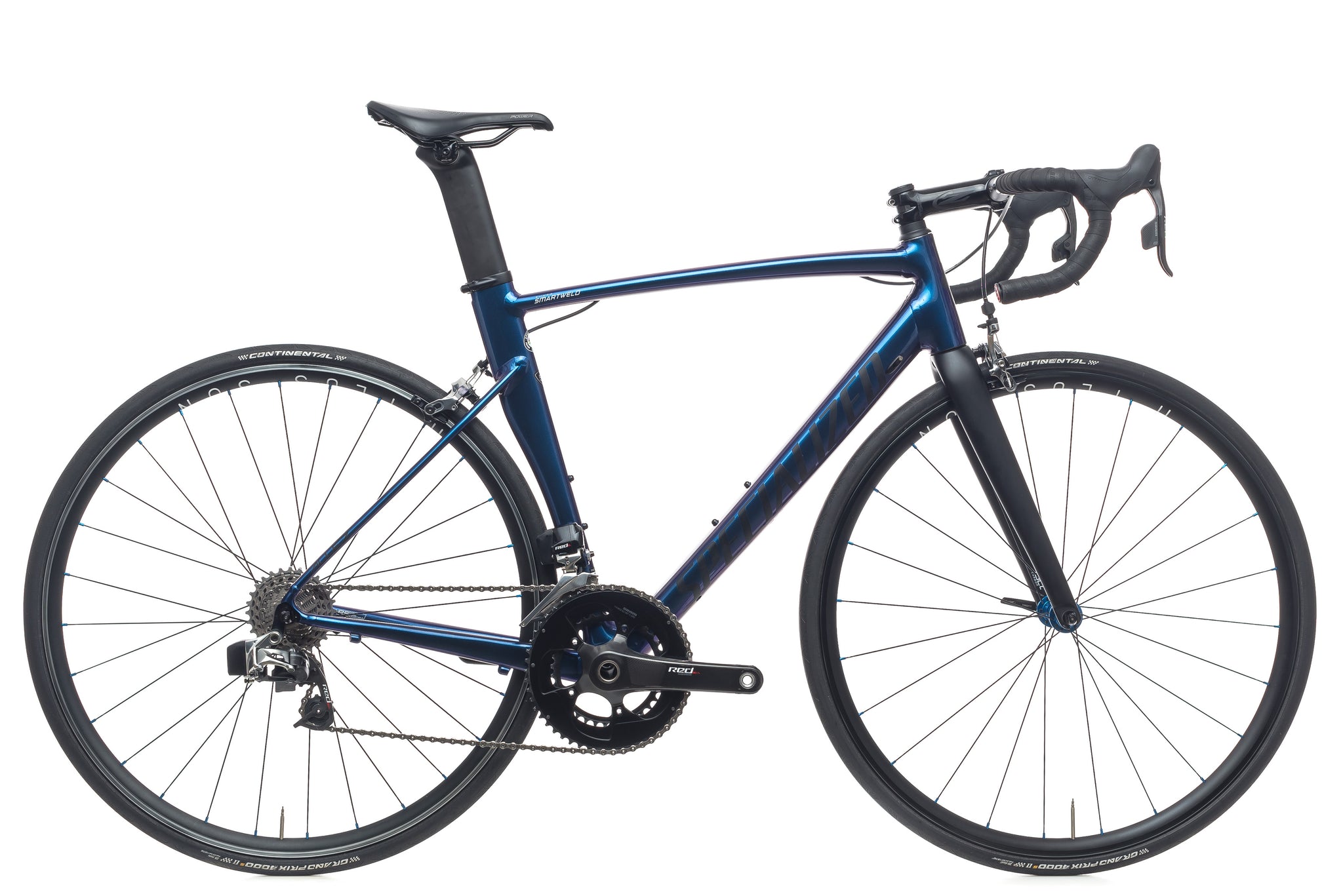
The Specialized Allez Sprint is a favorite of competitive crit and road racers, especially those looking for one of the fastest budget bikes available. If the Allez is an alloy Tarmac equivalent, the Allez Sprint is an alloy Venge. The aluminum tubing is hydroformed into an aerodynamic shape and because of the D'Aluisio Smartweld (DSW) technology used in its construction, it is significantly stiffer than any other road racing bike Specialized offers. While the Allez Sprint may be harsh on rougher roads and longer rides, the exceptional stiffness means it has great power transfer and very responsive handling. The Allez sprint is an all-out race machine, and there have been instances of pros choosing the Allez Sprint to race criteriums.
Endurance Road Bikes
Endurance road bikes are designed to improve comfort and speed on rough road surfaces over long distances. The riding position will generally be more upright and the frame geometry will be slightly more relaxed for a more comfortable and stable ride.
Roubaix
Frame material: Carbon
Who it's for: Riders looking for a fast bike that’s still comfortable to ride for long distances and over rough roads and some unpaved surfaces. 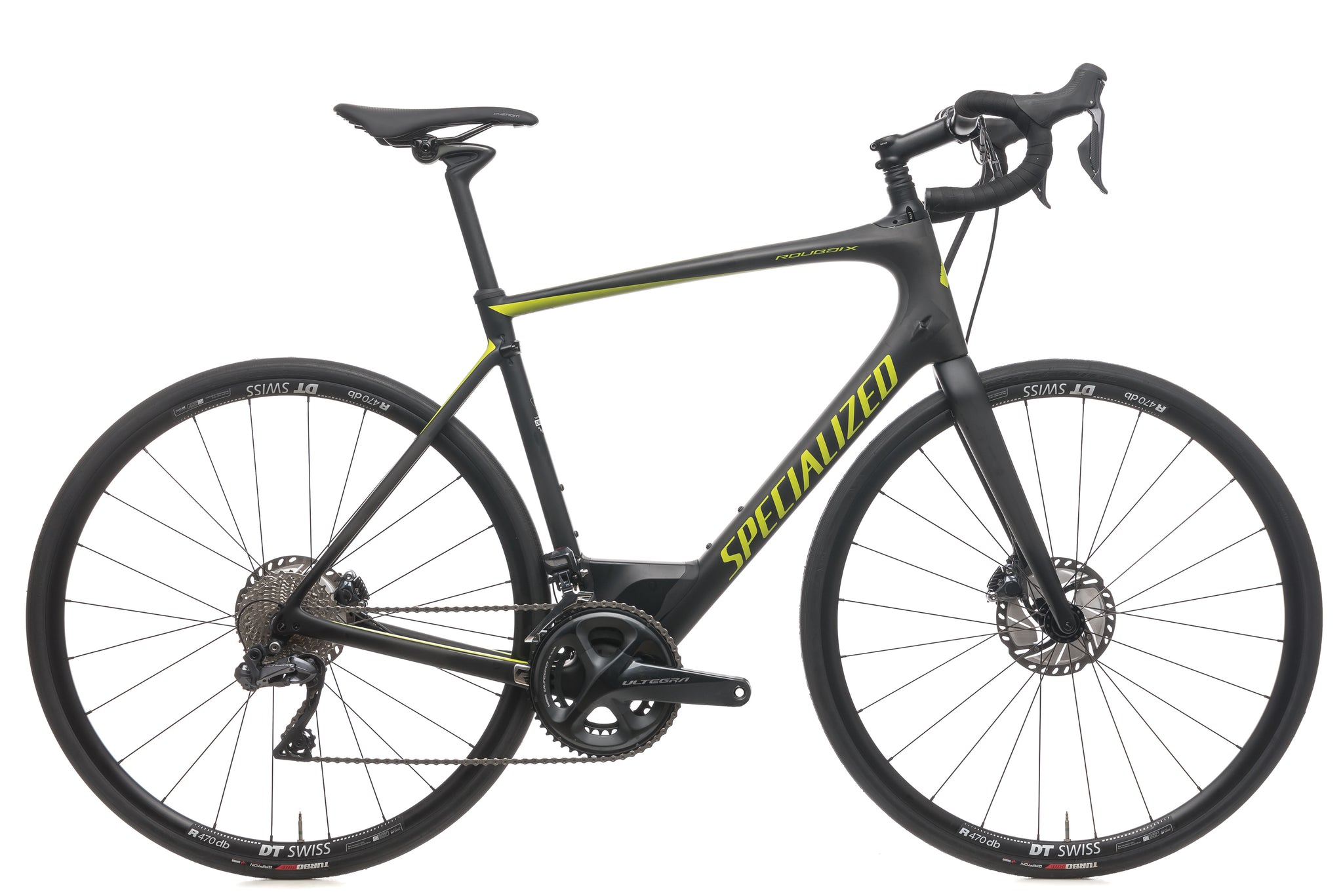
The Specialized Roubaix is named for the legendary Paris-Roubaix, a brutally hard race that takes riders through the rough cobbled farm roads of northern France. The Roubaix is an endurance bike designed to have the efficiency and speed racers need, but with extra frame compliance to help absorb bumps. This has made the Roubaix a favorite for riders seeking more comfort for long rides or those who venture onto rarely traveled, rarely maintained roads. The newest version of the Roubaix has Future Shock technology, which provides a small amount of suspension at the cockpit to further improve comfort and control.
Related bikes: Women's endurance bikes have been discontinued since 2019 and the Roubaix is now a gender neutral platform. Previously, the Specialized Ruby was the women’s equivalent of the Specialized Roubaix. The Specialized Dolce was similar to the Specialized Ruby, but came in at a lower price thanks to an aluminum frame and more affordable components.
Touring Bikes
Touring bikes are designed to help riders comfortably and efficiently travel extreme distances, often over multiple days.
AWOL (discontinued)
Frame material: Steel
Who it's for: Bikepackers and long-distance tourers
The Specialized AWOL is a steel touring bike that is designed to be compliant and comfortable for multi-day adventures. It has plenty of mounts for racks and fenders. The clearance to fit larger 45mm tires also makes the AWOL a good option for touring on gravel and singletrack. The long, upright geometry makes the bike both comfortable and stable, even when loaded up with bags and gear. AWOL means “absent without leave,” and it’s a bike built to take riders far away, over mountain passes, down endless gravel roads, and even through twisting singletrack with everything a rider needs to be self-sufficient.
The AWOL has been discontinued as of 2018 and has been replaced by the Sequoia.
Gravel / Cyclocross Bikes
Cyclocross and Gravel bikes are drop-bar bikes designed to handle all-terrain riding. These bikes split the difference between the speed and efficiency of road bikes and the off-road capabilities of mountain bikes. For more information on gravel and cyclocross bikes see our Gravel/Cyclocross Bike Buyer’s Guide.
All-Road Bikes
All-road style gravel bikes are lightweight and have the gearing and tire clearance to handle gravel but are more versatile for riders who spend their time riding on the road as well.
Diverge
Frame material: Carbon or Aluminum
Who it's for: Gravel racers and riders who need a versatile gravel bike that’s still fast and efficient on paved road sections. 
The Specialized Diverge is designed to be capable and fun on dirt, gravel, and flowy singletrack but also to get riders there fast. The Diverge's geometry is slightly more relaxed than a road bike to make it more stable when riding off-road, but still quick and responsive. Thanks to its light weight and quick handling, the Diverge is a good option for riders who want to tackle gravel roads with the same sort of speed and performance a dedicated road bike has on paved roads. Clearance for 38mm tires and additional compliance built into the frame improves traction and bump absorption. The addition of Future Shock technology also provides a small amount of suspension at the cockpit to further improve comfort and control.
If you're looking for a gravel bike that edges closer to mountain bike capability, the the Diverge Evo might be up your alley. It ditches the drop handlebars for mountain bike-style flat handlebars that give you more control in technical terrain. It also has clearance for big 700c 47mm tires or 650b 2.1" tires. It is only available in the robust E5 aluminum frame.
Cyclocross Bikes
Cyclocross bikes are built for cyclocross racing and have clearance for knobby tires, cantilever or disc brakes, and are designed to be easily shouldered while running.
CruX
Frame material: Carbon or Aluminum
Who it's for: Cyclocross racers and riders looking for a light, responsive, and versatile off-road capable bike. 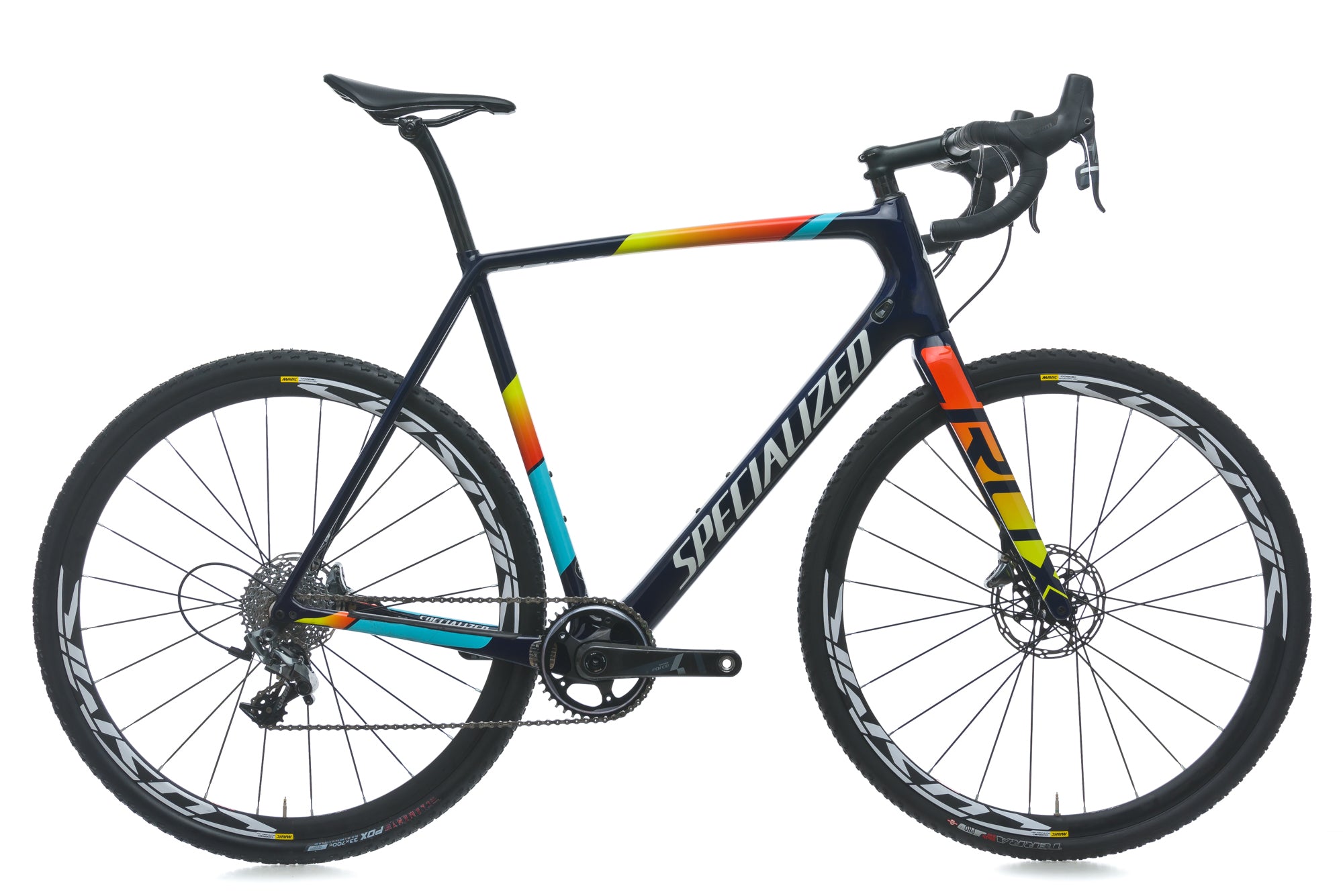
The Specialized CruX has been developed over the years to handle hard cyclocross racing which often involves sand, mud, grass, and obstacles that require riders to dismount and run while carrying their bikes. The CruX is light and stiff to accelerate quickly and easily out of corners. It has more aggressive geometry than a gravel bike. This helps it navigate technical courses and react quickly when racing in tight quarters with other riders. The CruX does not have as much tire clearance or compliance as the gravel-oriented Diverge, but many riders will still use cyclocross bike like the CruX for gravel and off-road riding because of their availability, lighter weight, and sporty handling. A true cyclocross bike will also be faster for the specific demands of cyclocross racing.
Adventure Bikes
Adventure gravel bikes push the boundaries of geometry, wheel, and tires. They excel at rougher gravel roads and light singletrack trails.
Sequoia (discontinued)
Frame material: Steel
Who it's for: All-around gravel riders who might do a little light touring 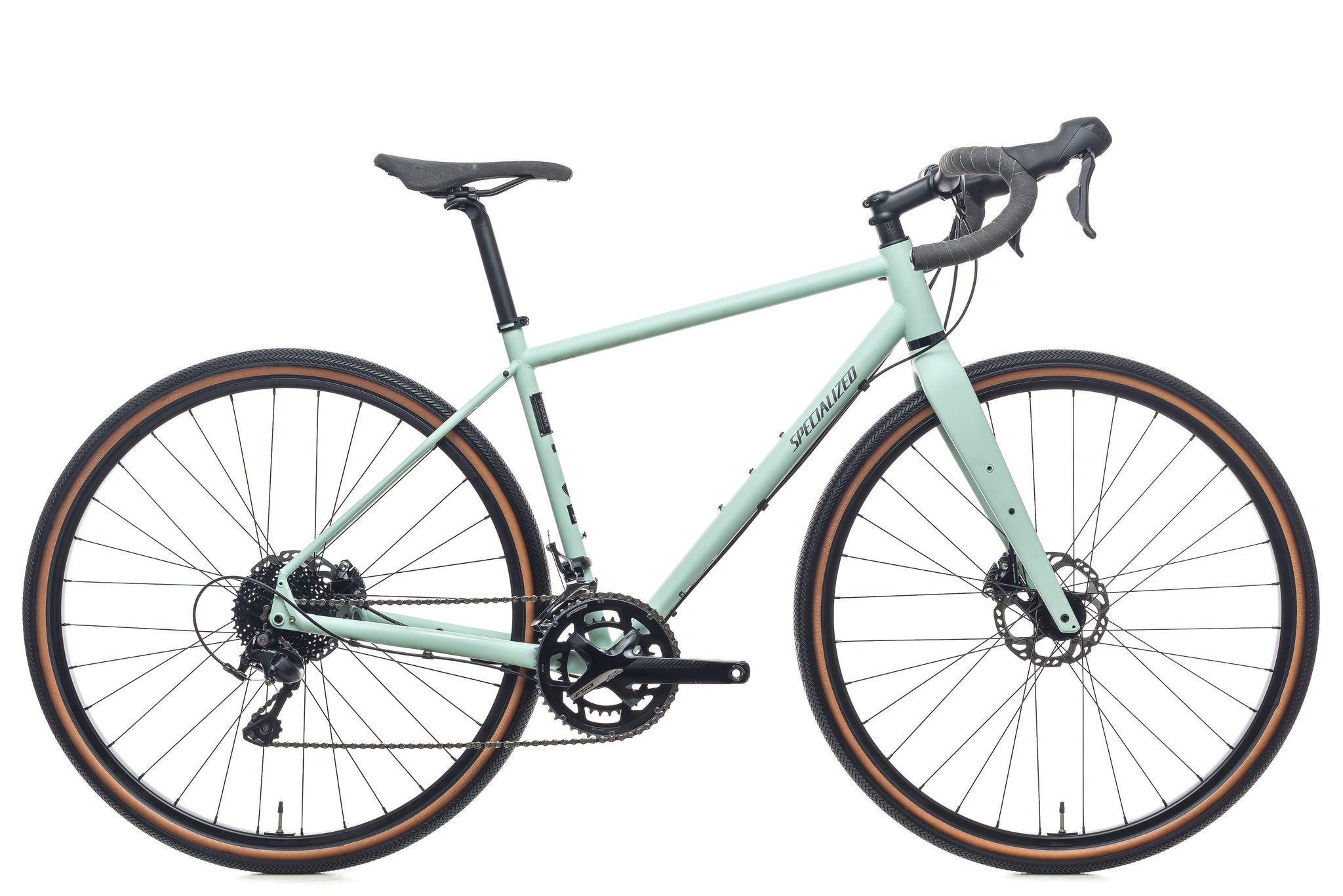
The Specialized Sequoia is a steel adventure gravel bike designed to maximize the rider’s comfort for long-distance dirt and gravel epics. The Sequoia isn’t as light and sporty as the racier Specialized Diverge, but it is rugged, dependable, and, most importantly, comfortable. For many riders, the supple ride of steel is unmatched, and the Sequoia utilizes premium cro-moly tubing with ultra-thin seat stays to maximize compliance. You can fit massive 45mm tires, which also greatly enhance comfort and traction. It has stable, relaxed geometry for long stints in the saddle and the frame has mounts for bags and fender if desired, making the Sequoia a good option for light off-road touring.
As of 2020 the Sequoia has been discontinued in favor of the Diverge gravel bike.
Time Trial / Triathlon Bikes
Time trials and the bike leg of triathlons are all about a single rider racing against the clock. TT/Tri bikes are designed to be as aerodynamically efficient as possible and are very specific tools that generally aren’t as good for casual riding or group rides.
Shiv
Frame material: Carbon
Who it's for: Time trial and triathlon racers
The Specialized Shiv is one of the most popular TT/Tri bikes available and has experienced a great amount of success at the professional level. The Shiv has been extensively tested and shaped in the wind tunnel to ensure that it reduces drag as much as possible. The Shiv comes in a standard version and a TT version. The TT version has some small differences, including a different fork, to make it UCI-legal. This allows it to be used in pro-level competition. Most triathlons don’t require UCI-legal bikes, so the standard Shiv is preferable as it's the slightly faster option.
Mountain Bikes
Mountain bikes are designed for trails and off-road riding. Specialized offers a wide range of mountain bikes that fit into several different styles of riding. For more information on mountain bikes see our Mountain Bike Buyer’s Guide.
Wheel Size
Many Specialized mountain bikes are available in either 27.5” or 29” wheel versions. Wheel size is often a personal preference. To learn more about wheel size see the Mountain Bike Buyer’s Guide.
XC Bikes
XC (a.k.a. cross-country) mountain bikes are lighter, easier to pedal, and have quick and responsive handling. They are good for riders focused on fitness, speed, climbing, endurance, long distance rides, and XC racing.
Epic
Frame material: Carbon or Aluminum
Wheel size: 29”
Travel: 100mm front / 100mm rear
Who it's for: Cross-country racers. Climbing- and endurance-focused riders who want the extra compliance of rear suspension. 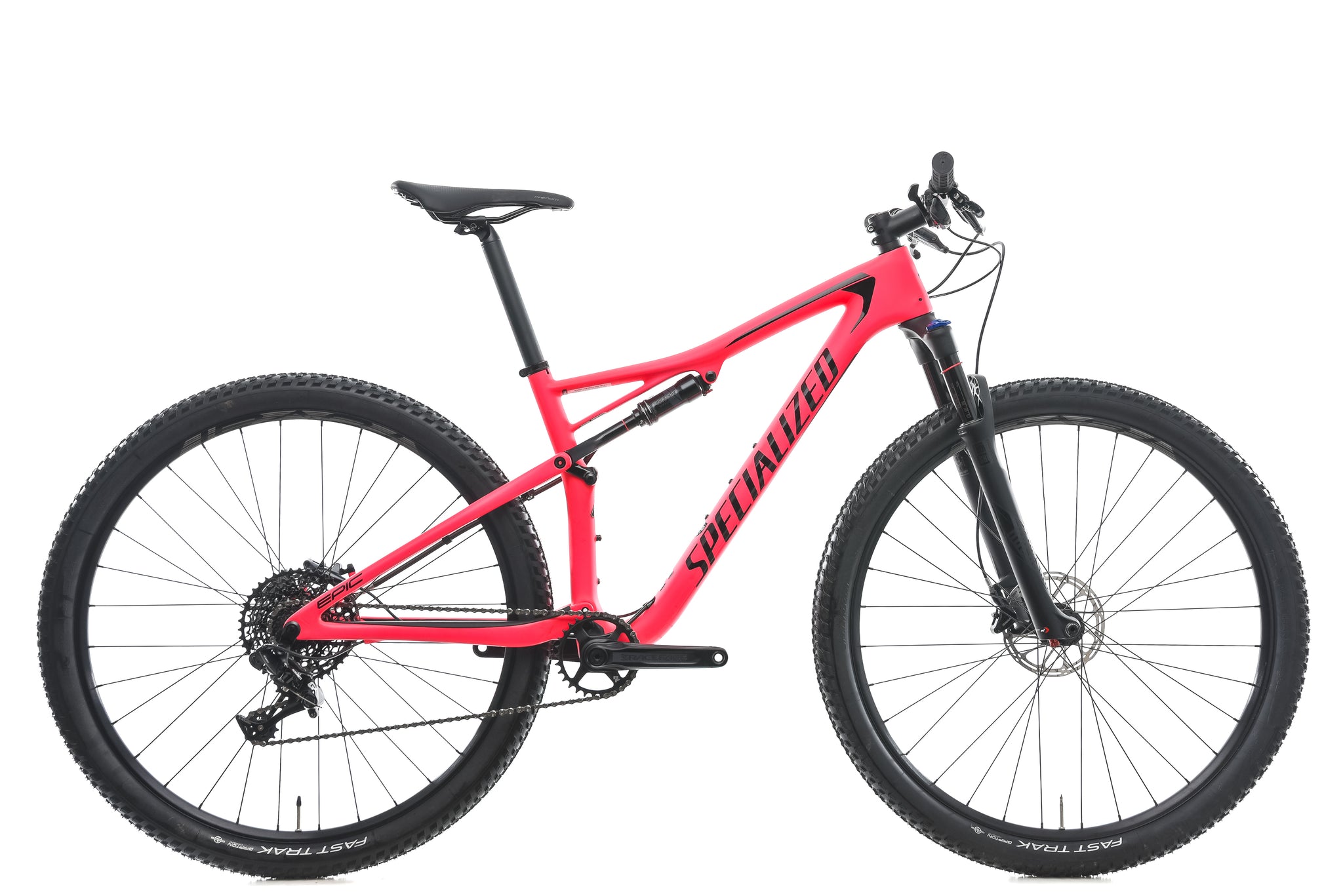
The Specialized Epic is one of the most popular and successful XC race bikes of all time. The Epic is a lightweight 100mm full-suspension bike. It uses Specialized’s proprietary Brain damper in the rear suspension, which keeps the suspension stiff and efficient for pedaling but opens upon impact to allow active suspension motion. This means a rider doesn't have to think about locking and unlocking his or her suspension during a race. Some Epic builds also use the Brain damper in the fork to provide a complete front and rear pedaling platform. The newest version of the Epic also has slightly more progressive geometry to improve its downhill performance.
Related Bikes: Era
The Era was the women’s specific version of the Epic. It has been discontinued since 2018.
Epic Hardtail
Frame material: Carbon
Wheel size: 29”
Travel: 100mm front
Who it's for: Cross-country racers and climbing- and endurance-focused riders who want the light weight and efficiency of a hardtail. 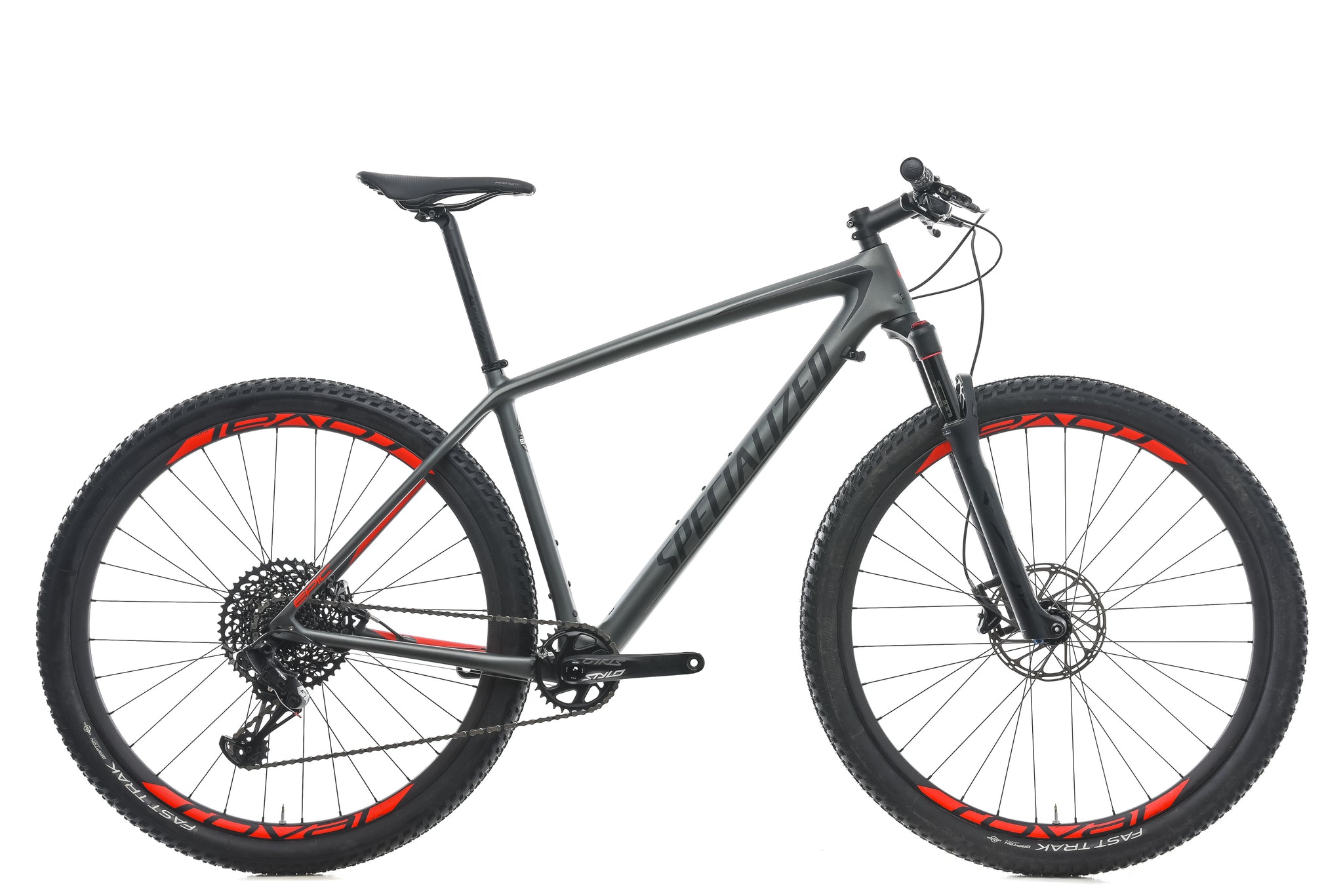
The Specialized Epic Hardtail is the lightest XC race bike Specialized offers. In fact the frame is also the lightest that Specialized produces. The Epic Hardtail is designed to dominate on the climbs. It also performs on smooth and flowy terrain, and during hard sprint efforts. Some builds are available with the Brain damper in the fork to provide the most efficient pedaling platform possible. Like the new Epic, the Epic Hardtail features more progressive geometry to improve its downhill performance.
Related Bikes: Stumpjumper Hardtail
The Stumpjumper Hardtail is the predecessor to the Epic Hardtail. The Stumpjumper Hardtail was replaced by the Epic Hardtail in 2017.
Chisel
Frame material: Aluminum
Wheel size: 29”
Travel: 100mm front - 90mm front (size small)
Who it's for: Cross-country racers on a budget and novice to intermediate riders interested in fitness and endurance.
The Specialized Chisel utilizes an aluminum frame to give aspiring XC racers and new riders a reliable and affordable point of entry. The frame is heavier than the Epic hardtail but much cheaper and robust. The geometry and handling match the Epic Hardtail, giving riders a good platform for progressing their riding.
Epic Evo
Frame material: Carbon or Aluminum
Wheel size: 29”
Travel: 120mm front / 100mm rear
Who it's for: Cross-country riders who want a light-duty trail bike with the efficiency and speed of an XC race bike.
The Specialized Epic Evo a progressive XC bike, meaning it has been modified to be less race-focused and more capable out on the trail. This is achieved by swapping the 100mm-travel fork to a longer-travel 120mm model. The fork is stiffer and it handles better when taking big hits in rough terrain. The taller fork also slacks out the headtube slightly to improve downhill handling. Knobbier trail tires and a dropper post also make the Epic Evo capable for aggressive riding. It is the ideal bike for riders who want the climbing benefits of an XC bike, but desire something slightly more fun and confidence-inspiring when railing it back downhill.
Trail Bikes
Trail mountain bikes are all-rounders that can handle uphills as well as downhills. They are usually the best choice for the majority of riders looking to have fun on a variety of trails.
Fuse
Frame material: AluminumWheel size: 27.5+
Travel: 120mm front
Who it's for: Novice to intermediate trail riders on a budget, looking for a solid, fun, uncomplicated bike. Great for experts looking to sharpen skills or make technical trails more exciting.
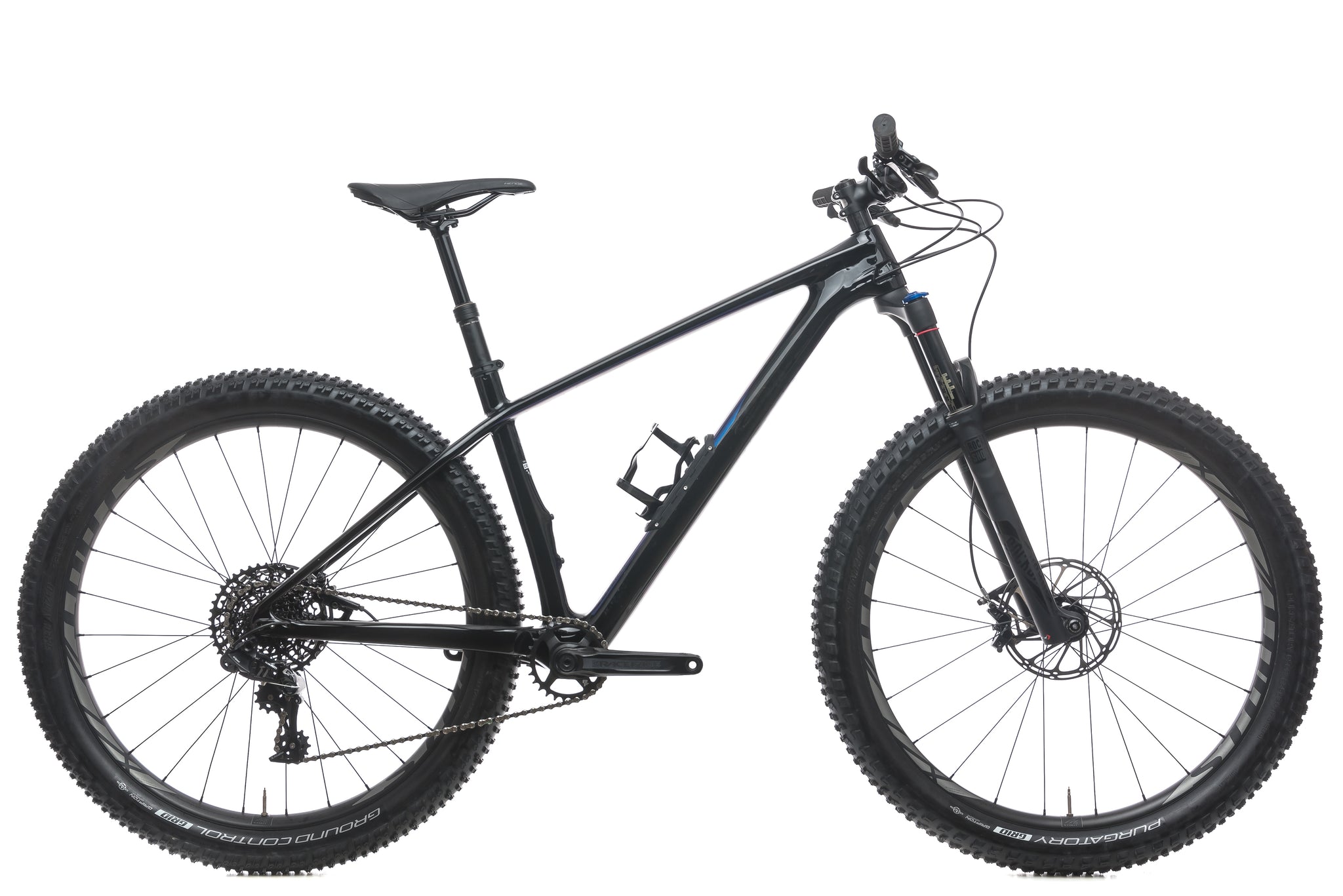
The Specialized Fuse utilizes 27.5+ wheels and tires to create a fun and capable platform that will appeal to many trail riders. "Plus" tires increase traction and comfort on loose and rough terrain. Their stability can also inspire more confidence in beginner riders. A 120mm-travel fork makes the Fuse plenty capable on most trails, while the hardtail design keeps the whole package simple, easy to maintain, affordable, and fun.
Related Bikes: Carve / Crave
The Carve (later renamed the Crave) is the predecessor to the Fuse. The Carve and Crave were replaced by the Fuse in 2019.
To learn more about the benefits of 27.5+ tires see our Plus Tire Review.
Stumpjumper ST (discontinued)
Frame material: Carbon or Aluminum
Wheelsize: 27.5” or 29”
Travel: 130mm front / 130mm rear (27.5”); 130mm front / 120mm rear (29”)
Who it's for: Trail riders looking for a versatile bike that pedals very well on climbs and long rides, but has the travel and geometry to outperform an XC bike on descents and technical trails.
The Specialized Stumpjumper ST takes the versatile Stumpjumper platform and reduces the travel. The ST stands for “short travel.” This leads to a bike that is an ideal blend of uphill speed and downhill performance. The reduced travel combined with the Stumpjumper ST’s steeper geometry means the bike will feel more responsive and efficient than the standard Stumpjumper, a desirable trait for people who ride mellower trails. Some might see this bike as a do-it-all quiver killer. It’s the perfect intermediate choice for riders looking for something between the raciness of the Epic and the trail focus of the standard Stumpjumper.
The Stumpjumper ST has been discontinued after 2020. The new 2021+ Stumpjumper now replaces both the Stumpjumper ST and Stumpjumper with 130mm of rear travel and 29" wheels.
Related Bikes: Camber
The Camber is the predecessor to the Stumpjumper ST. It was replaced by the Stumpjumper ST in 2018.
Stumpjumper
Frame material: Carbon or Aluminum
Wheel size: 29”
Travel: 140mm front / 130mm rear
Who it's for: Trail riders looking for a versatile bike that can effectively handle technical and gnarly terrain while still pedaling well on climbs and longer rides. 
The Specialized Stumpjumper has been a staple of Specialized’s lineup since 1981, but a lot has changed since then. Today, it is the quintessential trail bike, able to handle singletrack that ranges from smooth and flowy to steep and technical. It’s not too big to pedal all day, and when the trail turns fast and gnarly, it can confidently ride it out. It won’t be as fast on climbs and long-distance rides as the ultra-light and efficient Epic, and the rear end doesn't feel as plush and forgiving as the long-travel Enduro, but it bridges the gap between the two as the ultimate trail bike.
The Stumpjumper was redesigned in 2018 to be stiffer and lighter, with more travel and modern geometry that is longer and slacker. It was available with either 27.5" wheels and 150mm of travel front and rear or 29" wheels and 150mm travel front and 140mm travel rear.
For 2021, The Stumpjumper has 140mm of front travel and 130mm of rear travel. It replaces both the previous generation Stumpjumper and the Stumpjumper ST. It is only available with 29" wheels.
Related bikes: Stumpjumper 6Fattie, Rhyme, Stumpjumper ST
The Stumpjumper 6Fattie is a 27.5+ wheel version of the Stumpjumper. It has the same geometry and travel as the previous generation Stumpjumper 29 (150mm front / 135mm rear). The Rhyme is a women’s trail bike based on the previous generation Stumpjumper. It had 27.5, 6fattie, and 29 versions. Both have been discontinued since 2018.
Enduro Bikes
Enduro mountain bikes have more suspension travel, aggressive geometry geared toward downhill stability, and heavier, more rugged componentry. They are good for riding steep and technical terrain, bike parks, and enduro races.
Stumpjumper Evo
Frame material: Carbon or Aluminum
Wheel size: 29”
Travel: 160mm (front) / 150mm (rear)
Who it's for: Downhill-focused trail riders and enduro racers interested in riding a bike with more progressive geometry.
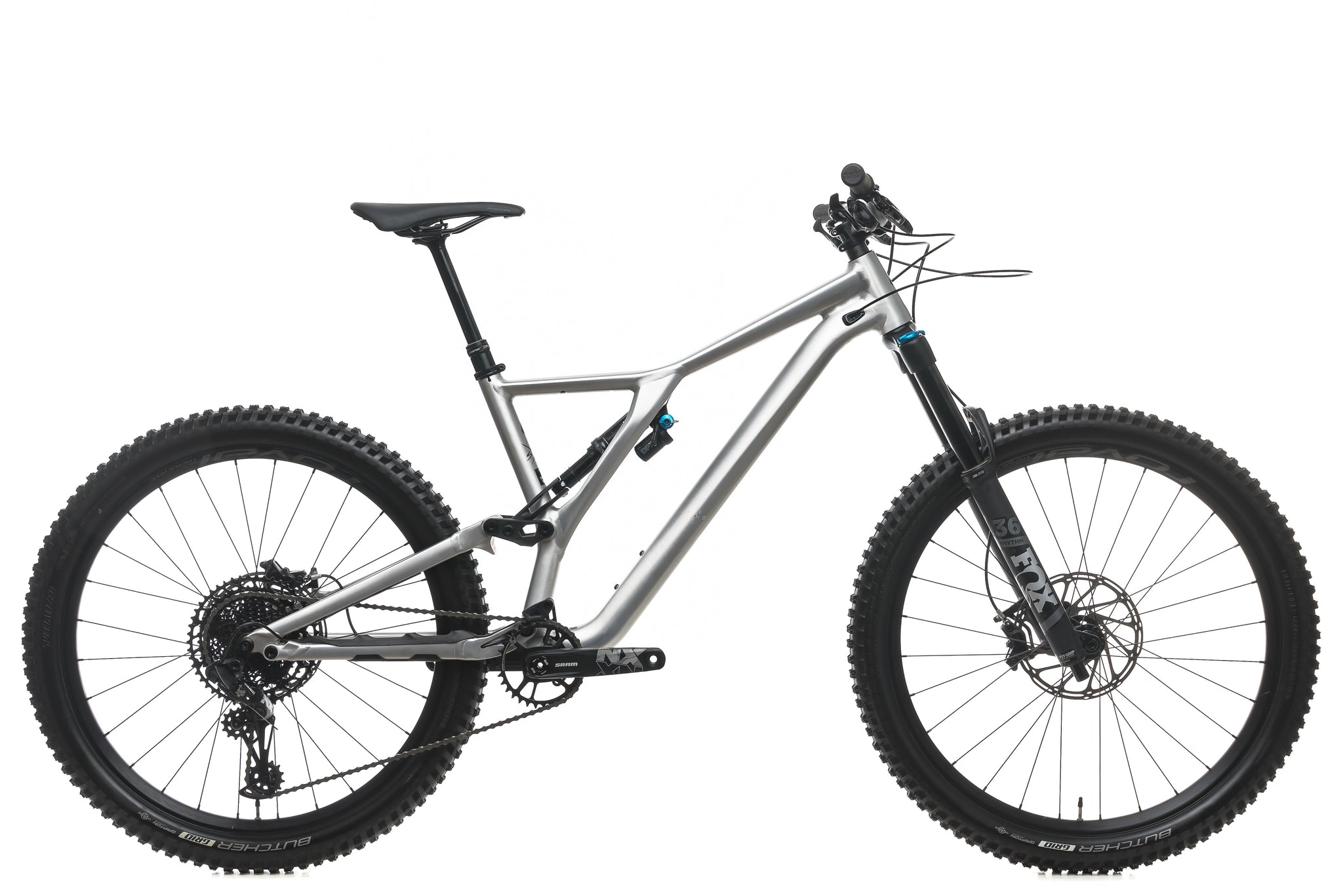
The Specialized Stumpjumper Evo was an experiment to cross-breed a trail and enduro bike. Specialized gave it the most progressive geometry it has ever produced with an impressively slack 63.5-degree head tube and a very long reach. Downhillers have long touted the benefits of slack head tubes and long reach, and the Stumpjumper Evo takes that to the extreme. Specialized first produced the Stumpjumper Evo in aluminum to test the waters, and after surprising demand, it released a carbon version as well. The Stumpjumper Evo only comes in two sizes, S2 and S3, which roughly equate to medium and large. For many riders interested in pushing to boundaries of geometry to improve downhill performance, the Stumpjumper Evo is the bike they’ve been waiting for.
The previous generation Stumpjumper Evo was available with 27.5" wheels and 150mm front and rear or 29" wheels and 150mm travel front and 140mm rear.
For 2021, the Stumpjumper Evo has been updated to be even more capable with 29" wheels only and 160mm of travel front and 150mm rear. It has highly adjustable geometry to suit many different riders and downhill conditions.
Enduro
Frame material: Carbon or Aluminum
Wheel size: 27.5” or 29”
Travel: 170mm front / 170mm rear (27.5”); 160mm front / 160mm rear (29”)
Who it's for: Downhill-focused trail riders and enduro racers who want a large amount of travel to handle big hits and gnarly terrain. 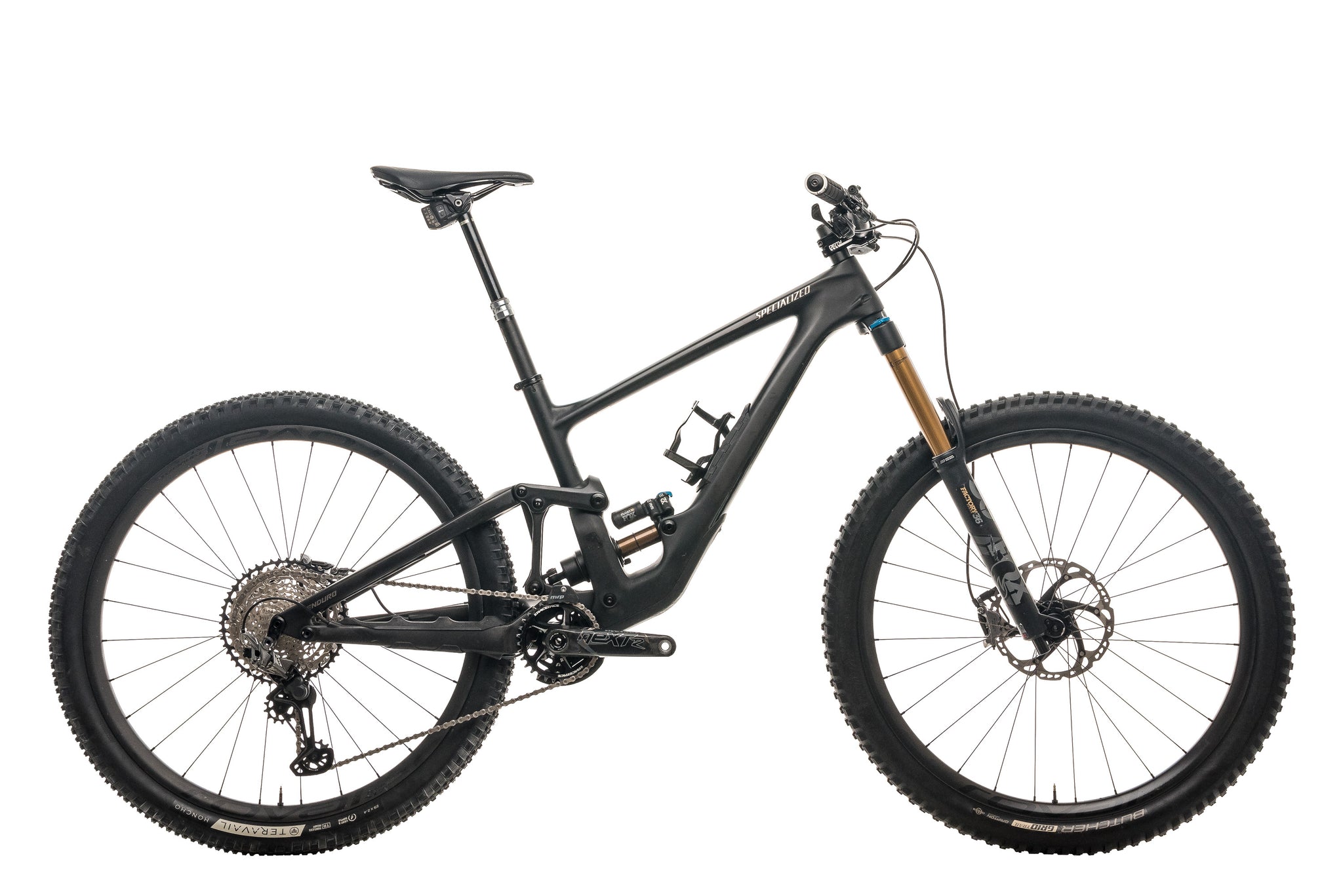
The Specialized Enduro is designed to be super-capable on downhills, while still being efficient enough to pedal back to the top of the hill. Long travel means the Enduro is able to hit jumps, drops, and rough trails with more comfort and a greater margin for error. This means riders can go faster and attack the trail harder. Though the Enduro can climb comfortably, that is not its primary purpose. Riders who choose the Enduro must be committed to sacrificing climbing ability in exchange for downhill performance. There’s very little downhill terrain that the Enduro can’t handle.
The previous generation Enduro offered both 27.5" and 29" wheels with 170mm and 160mm of travel respectively.
For 2020, the Enduro has been redesigned with a new suspension layout, longer and slacker geometry, 170mm of suspension travel front and rear, and 29" wheels.
Downhill Bikes
Downhill mountain bikes are designed to go downhill as fast as possible — pretty straightforward, right? Downhill bikes don’t pedal or climb well and are best suited to lift-served downhill bike parks and shuttling.
Demo
Frame material: Carbon or Aluminum
Wheel size: 27.5”
Travel: 200mm front / 200mm rear
Who it's for: Downhill racers, dedicated bike park riders, and freeriders who need the burliest mountain bike possible. 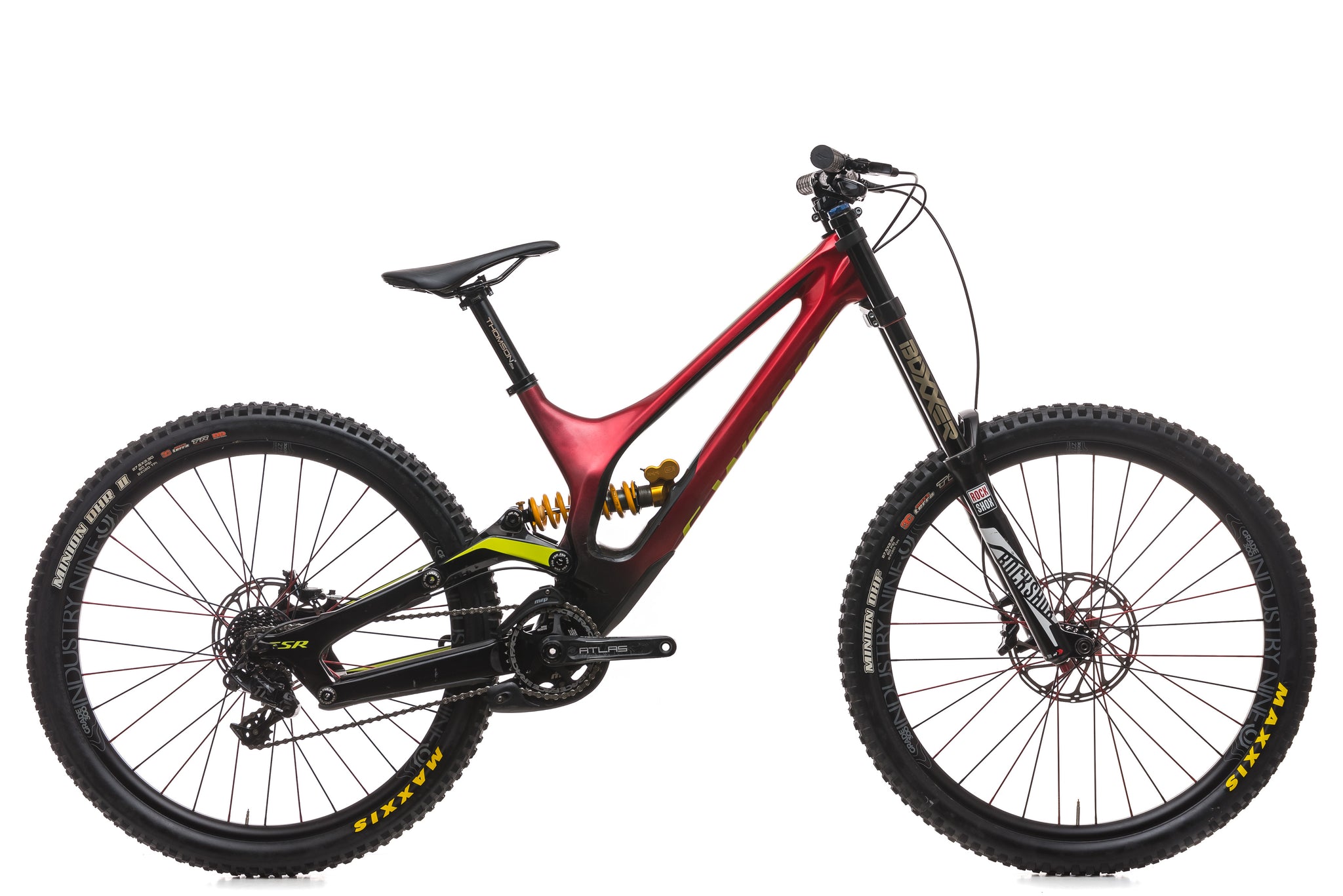
The Specialized Demo is uncompromising in its pursuit of downhill speed. It is not a bike that will be pedaled on normal trails without chairlifts unless riders are getting shuttled or are hiking to the top. But because the Demo has the most suspension travel available and purely downhill-focused geometry, it is hard to match on the roughest trails. It can be ridden hard and fast over gnarly terrain. The Demo has been developed to compete at the World Cup level. It is the choice of competitive downhill racers, daring freeriders, and park rats who like to spend their summers riding lift-accessed trails. Many riders feel that downhill bikes like the Demo greatly increase their confidence on the steepest and hardest trails around.
Fat Bikes
Fat bike tires are generally 3.8-5.0” wide. This ultra-wide, low-pressure rubber allows fat bikes to ride with some amount of “float,” meaning the tire doesn’t sink into the trail surface. This makes fat bikes ideal for riding in extreme conditions like snow and deep sand.
Fatboy
Frame material: Carbon or Aluminum
Wheel size: 26” Fat
Travel: Rigid
Who it's for: Riders who want to float through snow and sand, or anyone looking to experience the fun and traction of oversized tires. 
The Specialized Fatboy comes with 4.6” tires to maximize float, and turn up the fun factor. Fat tires have become much more than just a novelty. Wide tires dominate in unique conditions like snow and deep sand, where normal bikes will lose traction or bog down. And now, some riders will even ride fat bikes in normal trail conditions, simply because the oversized tires provide ridiculous amounts of traction and comfort.


